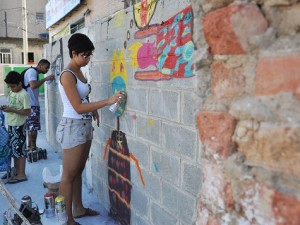 Mário Lucas, 18, was brutally murdered by two plainclothes police officers in his own home in Morro da Fazendinha, in Complexo do Alemão on the morning of November 26, 2012. Two days later, a curfew was imposed in Borel. These two incidents motivated Luciano Garcia, businessman and advertising student and resident of Complexo do Alemão, to join a group of other youth from nearby Borel to organize an event to protest the violence of the Pacifying Police (UPP). Inspired by movements around the globe following Occupy Wall Street, Occupy Alemão and Occupy Borel were the first such initiatives organized by young people in Rio’s favelas.
Mário Lucas, 18, was brutally murdered by two plainclothes police officers in his own home in Morro da Fazendinha, in Complexo do Alemão on the morning of November 26, 2012. Two days later, a curfew was imposed in Borel. These two incidents motivated Luciano Garcia, businessman and advertising student and resident of Complexo do Alemão, to join a group of other youth from nearby Borel to organize an event to protest the violence of the Pacifying Police (UPP). Inspired by movements around the globe following Occupy Wall Street, Occupy Alemão and Occupy Borel were the first such initiatives organized by young people in Rio’s favelas.
Military Police officers would drive around in unmarked cars saying the favela now belonged to the police. “How can that be? It used to belong to the drug traffickers and now it belongs to the police; when will it be ours? The favela has always belonged to the residents,” complained Luciano, recalling how upset his four-year-old daughter was at witnessing his sister-in-law humiliated by a brutal police frisking.
The event was held simultaneously in Borel and the favela of Nova Brasília on December 5th. The 9pm starting time was in direct response to the curfew and thus attracted the attention of residents, especially young people. With activities to raise political awareness, an open mic, and the delivery of a letter to the chief of the UPP, the event was a success. In fact, it spurred other communities to organize, and gave rise to the Occupy Alemão collective, a group, with no institutional or governmental support, for young people from Complexo do Alemão and other favelas to facilitate the political, cultural and personal occupation of public spaces.
“Occupy Alemão is made up of young people who believe that a new world is possible, that favelas should be recognized as part of the city, and who have ideas about how to realize these objectives. Our struggle is for the rights of the city, and for democratic access,” explained journalist and media activist Thamyra Thâmara de Araújo, resident of Complexo do Alemão. She says that her involvement in the group “is based in friendship and affinity. The greatest connection we have is our desire to change the world.”
The collective is currently organizing a series of activities to strengthen ties between residents and the street. Following the arrival of the UPPs and, more recently, of urban mobility programs, alleys and public squares have been increasingly associated with prohibition and repression. Sociologist and researcher Patrícia Lânes believes that “this strategy of occupying public spaces in the favela could be crucial in promoting the debate about the extent to which squares, streets, and recreational, cultural and sports equipment are in fact public. The term ‘occupy’ reignites a discussion about who lays claim to these spaces, by the very people who have the right to them. Spaces that should be public are having their uses restricted, whether for safety or attempts at privatization.”
The establishment of resident-run free libraries, places for the sharing of knowledge, that incorporate the communities’ buildings and landscape is just one of Occupy Alemão’s initiatives to help restore the public nature of space in the favela. The first free library was launched in May, in Morro dos Mineiros, the least urbanized favela in Complexo do Alemão.
Another action is the Rolé Afetivo, a walking tour of the streets of Complexo do Alemão that ends with an informal discussion about key topics in the fight for rights and involvement in the favela. The collective is also planning open-air movies and political graffiti events that combine art, culture and political involvement. Also in the works is a network to facilitate communication in the communities, and audiovisual media workshops for young people.
 Occupy Alemão is also active on social networks, where they post important topics for the group and strengthen their connection to other groups. According to Patrícia Lânes, co-author of the study “Poor Youth and the Use of New ICTs to Create New Public Democratic Realms,” the use of digital media changes both political and social engagement. She says, “Many of the people interviewed in the study said they used the Internet and social networks to communicate more [with people] outside than within the favelas. This is still an important issue that should be explored. But the young people in the study don’t see this as a contradiction, rather as a connection between online and offline. That is, you have to be on the network but you also need meaningful action in your neighborhood.”
Occupy Alemão is also active on social networks, where they post important topics for the group and strengthen their connection to other groups. According to Patrícia Lânes, co-author of the study “Poor Youth and the Use of New ICTs to Create New Public Democratic Realms,” the use of digital media changes both political and social engagement. She says, “Many of the people interviewed in the study said they used the Internet and social networks to communicate more [with people] outside than within the favelas. This is still an important issue that should be explored. But the young people in the study don’t see this as a contradiction, rather as a connection between online and offline. That is, you have to be on the network but you also need meaningful action in your neighborhood.”
